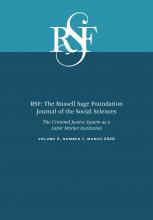Research Article
Open Access
Locked Out of the Labor Market? State-Level Hidden Sentences and the Labor Market Outcomes of Recently Incarcerated Young Adults
Cody Warner, Joshua Kaiser, Jason N. Houle
RSF: The Russell Sage Foundation Journal of the Social Sciences March 2020, 6 (1) 132-151; DOI: https://doi.org/10.7758/RSF.2020.6.1.06
Cody Warner
aAssociate professor in the Department of Sociology and Anthropology at Montana State University
Joshua Kaiser
bResident scholar in sociology at Dartmouth College
Jason N. Houle
cAssociate professor in sociology at Dartmouth College

REFERENCES
- ↵
- American Bar Association (ABA)
- ↵
- ↵
- Apel, Robert, and
- Anke Ramakers
- ↵
- ↵
- Beckett, Katherine, and
- Steve Herbert
- ↵
- Blau, Peter M., and
- Otis Dudley Duncan
- ↵
- Brayne, Sarah
- ↵
- ↵
- ↵
- Carson, E. Ann
- ↵
- ↵
- Chin, Gabriel J
- ↵
- ↵
- DiPrete, Thomas A., and
- Gregory M. Eirich
- ↵
- ↵
- ↵
- Harris, Alexes
- ↵
- ↵
- Herd, Pamela, and
- Donald P. Moynihan
- ↵
- Holzer, Harry J
- ↵
- ↵
- Kaiser, Joshua H
- ↵
- ↵
- Love, Margaret, and
- David Schlussel
- ↵
- ↵
- Miller, Reuben Jonathan, and
- Forrest Stuart
- ↵
- ↵
- ↵
- Pager, Devah
- ↵
- Paternoster, Raymond,
- Robert Brame,
- Paul Mazerolle, and
- Alex Piquero
- ↵
- Petersilia, Joan
- ↵
- Pettit, Becky, and
- Bruce Western
- ↵
- ↵
- Raphael, Steven
- ↵
- ↵
- Rindfuss, Ronald R
- ↵
- Sampson, Robert J., and
- John H. Laub
- ↵
- Shannon, Sarah K.S.,
- Christopher Uggen,
- Jason Schnittker,
- Melissa Thompson,
- Sara Wakefield, and
- Michael Massoglia
- ↵
- Silva, Jennifer M
- ↵
- ↵
- Stavsky, Mark M
- ↵
- ↵
- ↵
- ↵
- ↵
- Travis, Jeremy
- ↵
- Travis, Jeremy, and
- Bruce Western
- ↵
- Uggen, Christopher, and
- Jeff Manza
- ↵
- Uggen, Christopher, and
- Robert Stewart
- ↵
- University of Kentucky Center for Poverty Research (UKCPR)
- U.S. Bureau of Justice Statistics
- U.S. Bureau of Labor Statistics, Department of Labor
- U.S. Census Bureau
- U.S. Census Bureau
- U.S. Census Bureau
- ↵
- Vallas, Rebecca, and
- Sharon Dietrich
- ↵
- ↵
- Wakefield, Sara, and
- Christopher Uggen
- ↵
- Waldo, James,
- Herbert S. Lin, and
- Lynette I. Millett
- ↵
- Western, Bruce
- ↵
- Western, Bruce
- ↵
- ↵
- ↵
- ↵
In this issue
Locked Out of the Labor Market? State-Level Hidden Sentences and the Labor Market Outcomes of Recently Incarcerated Young Adults
Cody Warner, Joshua Kaiser, Jason N. Houle
RSF: The Russell Sage Foundation Journal of the Social Sciences Mar 2020, 6 (1) 132-151; DOI: 10.7758/RSF.2020.6.1.06





